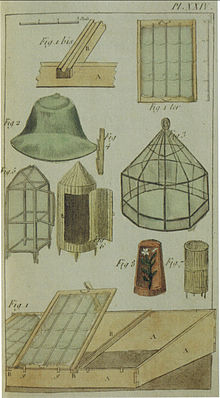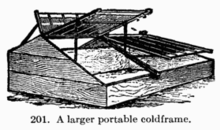Bell jar (horticulture)
Glass bells were used in horticulture for the protected and controlled cultivation of plants, especially for early forcing . They were less expensive forerunners to today's greenhouses before they were generally affordable. They were most widespread in French horticulture. Many commercial gardeners had tens of thousands of them in use there at the end of the 19th century. In the 20th century they lost their importance and production was discontinued, so that for a time only individual specimens could be viewed in museums.
In the 21st century, similar-looking hoods are once again available from some dealers as a decorative element for the garden. For reasons of cost and weight savings, however, these are usually made of transparent plastic. There are also occasional replicas made of glass that are true to the original. Both blown glass bells and those made of small leaded glass panes were widespread .
Glass bells
Blown glass bells have long been known as glass hoods made from window glass, which is more difficult to manufacture. In a wall painting on the parish church of Heiliger Kanzian in Nötsch im Gailtal from around 1500, a glass bell can be seen alongside other agricultural implements. In the Renaissance glass were stills relatively common and are for example in Kreuterbuch of Adam Lonicer displayed. The apparatus included a glass helmet in the shape of a bell with a handle, which some owners also used for early forcing . Clemens Alexander Wimmer suspects that the first glass bells were made in Venice. Traveling glassblowers later founded their own workshops in Bohemia, Thuringia and Lorraine, in which they made the bells in large numbers.
Around 1600, Olivier de Serres describes the use of glass bells, in the form of large hats with the shape of a bell at the bottom, as coverings in melon culture . Others would look like alembic helmets without any rim. The diameter of the bells with which the sown seeds were covered was one foot . To warm the soil further, he recommended adding fresh horse manure to the soil in the bed.
In 1631 Peter Lauremberg described glass bells with an opening at the top. The bell that was put over the crops during the day was intended to accelerate the germination and growth of early fruits. The opening, which could be closed if necessary, was used to allow evaporation and excessively warm air to escape. In France, this version was called the "English bell". However, the closed versions, which also provided protection from the cold at night, were more common. They are mentioned, among other things, in a list for a delivery to Gottorf Castle from 1633, by John Evelyn 1660 (with picture), by Johann Sigismund Elsholtz (1666) and by Wolf Albrecht Stromer von Reichenbach in 1671. The first described by John Evelyn Execution with a handle that you can touch was later the most widespread and was also described by Georg Andreas Böckler in 1678, Franz Philipp Florinus in 1702 and in the “Encyclopédie, ou ou Dictionnaire raisonné des sciences, des arts et des metiers” 1762. Most bells were six to eight inches in diameter. Larger versions with a diameter of up to 60 centimeters and small ones the size of a coffee cup were also produced . The color of the glass was different; In addition to bells made of clear glass, specimens in various green, blue and red tones were also offered. Bells made from dark bottle glass were the most widespread because they were offered at the lowest price. They let in more heat and less light, which is why they were also used to bleach cauliflower. Colorless glass bells made from clear glass were the most expensive.
It was ventilated under the glass bells by placing a wooden stand under the edge on the side from which the wind came. The wood could be provided with notches so that the opening could be set differently. When it was very hot, the bells were covered or, as described by Karl Theodor Rümpler , painted with lime milk . For storage, a straw hood was placed between two glass bells to protect against glass breakage .
Glass hoods
The first known mentions of glass hoods can be found in writings by John Evelyn from 1660, who also recommended them for displaying tulips and other ornamental plants. Johann Sigismund Elsholtz describes the hoods made of small leaded glass panes in 1666 as "round or angular / flat or pointed at the top". Some also had windows for ventilation. The disadvantage that they were more expensive to buy than the glass bells was partially offset by the fact that individual broken panes could be replaced. The glass was always clear, so compared to most glass bells, they let in less heat and at the same time more sun rays.
Simple models only had four inclined panes on the sides. In the French horticultural journal "Le Bon Jardinier" in 1774, twelve-sided designs that were almost round were recommended and also described in detail. Such a model can be seen in the picture below on the left. Recommended sizes were between six inches and two feet tall. Especially with larger models, it was advised to stabilize the lead border with iron wire when soldering it. Also, the wires from which the handle is formed should be run to the bottom of the hood.
In 1822, John Claudius Loudon made a distinction between models that are edged with copper, lead, or cast or wrought iron. The most expensive of these were the cast iron models, which consisted of two individually cast and then riveted side parts. The one-piece roof had the advantage that it could be removed even in frosty weather without damaging the glass. The cheapest were lead-glazed hoods, which, however, had a shorter lifespan and heavier weight than copper -glazed hoods .
Transition to greenhouses
The construction with cast or wrought iron bars allowed the construction of ever larger hoods. This developed into “miniature greenhouses”, whereby the transitions are fluid and difficult to define. Advances in the glass industry also made it possible to offer inexpensive, larger panes of glass with which the hotbed prevailed for early forcing. In the 20th century, both glass bells and the classic glass hoods disappeared from the market and from use.
Todays use
In May 2015, the magazine Bilanz described gardening as the new golfing. In line with the trend as a hobby for the wealthy, many expensive retro garden tools are on offer. These are not always more practical, but definitely more beautiful than the modern versions. In addition to galvanized watering cans or enameled signs, glass bells made from the original were also named as such.
literature
- Clemens Alexander Wimmer : Hip, Krail and Lawn Patsche - On the history of garden tools . Publishing house and database of the humanities, Weimar 2012, ISBN 978-3-89739-722-4 , pp. 208-213.
Web links
Individual evidence
- ↑ a b c d e Clemens Alexander Wimmer : Hippe, Krail and Rasenpatsche - On the history of gardening tools , publishing house and database of the humanities, Weimar, 2012, ISBN 978-3-89739-722-4 , pp. 208-211.
-
↑ * Website of a supplier , accessed on April 23, 2016.
- Vendor website , accessed April 23, 2016.
- ↑ a b c d Clemens Alexander Wimmer : Hippe, Krail and Rasenpatsche - On the history of gardening tools , publishing house and database of the humanities, Weimar, 2012, ISBN 978-3-89739-722-4 , pp. 211-213.
- ↑ Gardening - the new leisure trend on bilanz.ch, article from May 29, 2015; accessed on April 23, 2016.




